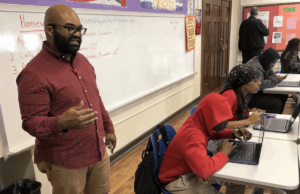The Role Of Advisory In Personalizing The Secondary Experience

The goal of an advisory is to help students figure out who they are, where they’re headed, and how they’re going to get there. Through an advisory system, each student has an adult who knows them and helps them navigate high school so that they leave with a meaningful, personalized plan and are prepared for postsecondary options.
An advisory is a key component of a distributed student guidance strategy that includes regular meetings between an advisor and a group of students, that meets at regular intervals, has a clear focus, and is something in which all students and staff participate in.
In the paper Core and More: Guiding and Personalizing College and Career Readiness, we asserted that the best student guidance systems are blended (leveraging technology and in-person instruction and services), distributed (leveraging staff in addition to school counselors), and scheduled (utilizing an advisory period). This advisory period is really the glue that holds it all together.
High school can be a confusing time with increasing options for students due to the rapid expansion of digital learning. Advisory has to be the spine of the next generation high school. Sustained adult relationships can help students navigate this new digital landscape.
Chris Lehmann, Science Leadership Academy (SLA), believes that student-teacher relationships radiate from the advisory period. “Think of advisory as the soul of your school. And in everything you do, remember that you teach students before you teach subjects. Advisory is the place in the schedule where that idea has its core and then it spreads into everything else we do,” Lehmann said (See feature).
Beth Brodie of Partnership for Change notes that a key function of the advisor is to ensure that every student has someone, “Who knows them well and supports them at school meetings and conferences.”
5 Core Elements
- Weekly academic monitoring, connections to academic support services
- Connection to youth and family services
- Support for positive school culture
- Support for career awareness
- Support for postsecondary education awareness and decision making
The American School Counselor Association (ASCA) National Model, emphasizes a distributed approach to implementing these elements. Norm Gysbers encourages schools to move from “position to program” when thinking about guidance. Accordingly, core elements of a quality advisory program are supported with expectations, outcomes, role clarity, and measurements.
10 Optional Elements
- Support social emotional development with learning experiences and feedback
- Support identification of and preparation for work-based learning
- Provide support for college applications and dual enrollment options
- Foster peer learning and team building experiences
- Support health and wellness learning experiences
- Teach innovation mindset, including growth, team, and maker elements
- Teach life skills including financial literacy, digital citizenship, and carrying out school routines
- Prepare for student-led conferences
- Facilitate cross-curricular project work
- Involve community partners as guest speakers and local experts
Delivery Options
Size. Advisory groups are typically 18-22 students. To achieve smaller groups, administrators often take on advisory roles.
Frequency. Advisory periods are typically integral the school schedule, and typically anywhere from one to five times weekly for a period shorter than a class, such as 20 or 30 minutes long. Some schools elect to offer long, less frequent advisory periods.
Focus. Some focus on college and career preparation, others on academic support, others emphasize social and emotional learning and others, character development. Beth Brodie suggests the development of a vision statement and clear objectives prior to implementation. “Establishing a multi-stakeholder group to include teachers, students, parents administrators, and special educators to develop a vision statement and define objectives will lend itself to a lasting organizational change,” said Beth.=
Curriculum. Regardless of focus, advisory ought be supported by curriculum. Some choose to use an existing curriculum, others choose to write their own. The curriculum can help connect academic preparation, thought patterns, interests and learning to students’ college and career aspirations. You don’t have to do everything in advisory, but you do need to be clear about what you do.
One implementation example is SLA, where advisory is treated as a course, and the advisor serves as the advocate for the student and point-person for the family within the school. Advisors follow the same group from ninth to twelfth grade and spend two 40 minute periods with them each week.
Benefits
Connection to peers. A strong advisory program helps students get connected to one another in meaningful ways. Through class discussions, democratic classroom decision-making, Socratic seminars, and other activities, students can form bonds with one another and also learn more about themselves in relation to others. This is something we know is important for 21st century skill building, and the advisory can be a time to do this without the need to teach specific course content.
Connection to adults. A strong advisory system provides students meaningful relationships with adults. There is research to suggest that strong adult mentorship while in high school increases the likelihood of graduation and postsecondary success (see William Sedlacek’s work with GMSP).
Advocacy. A strong advisor-advisee relationship means that the student has an advocate in the school building. This means the student can feel supported, and if or when that student faces some personal or academic difficulty, rather than mentally or physically “checking out,” the student has someone to go to for help, feedback, and assistance.
Personal Growth. Because of the student’s personal connections to an adult, the student can learn more about his/her academic and personal strengths and areas for improvement. A student’s own self-awareness is critical for success in college and beyond, and a good advisory program can help students become more self-aware through 1:1 discussions with their advisor and also time for those discussions as a peer group during the advisory time.
Lessons Learned
Persist. When Tom was a superintendent and implemented an advisory program, many faculty argued that they hadn’t signed up for that role. It is important for leaders to recognize this can be a scary change that requires both professional growth and a lot of persistence. Leaders ought not underestimate how substantial a role change being an advisor is for many high school teachers.
Ask questions, listen, and help students craft a vision. One thing that helped Bonnie as a high school advisor was reflecting on her own high school experience, remembering that not a single adult (including her own parents) asked her what her vision was for herself after high school. In contrast, when she was an advisor, she understood the importance of asking students what their vision was for their lives after high school. She also listened to their responses without judgment, and was amazed to see how students’ visions for themselves shifted over time. By consistently thinking about their vision and planning strategic goals to support it, students can see beyond high school and into their future options.
Draw connections and use data. As Mary served in district and state roles supporting advisory, one lesson learned was to emphasize the importance of helping students draw connections between current school activities and future goals. Students aren’t the only ones who benefit from connections, staff members do as well. For some, the appeal is the opportunity to connect with students. For others, it is knowing that advisory can move student outcomes in a big way. For example, schools participating in a six-year College Spark Washington initiative that includes advisory, have demonstrated graduation rates 20 percent higher than comparison schools.
Preparing for Life
A strong advisory program has adults who ask students lots of questions, and adults that show a genuine interest in listening to students’ responses, helps them create a vision for their futures, and then helps them enact strong goals to help them meet their goals- for college, career, and life.
An advisor’s job is to help students plan for that life through visioning, goal setting, asking questions, being an advocate, and simply being there for students.
Resources:
- Smart Series Paper – Core and More: Guiding and Personalizing College and Career
- ReadinessTeaching Channel: A Tale of Two Advisory Programs
- The Glossary of Education Reform: Advisory
- Partnership for Change (VT): 4 Part Series
- Education Northwest: What Research Says (And Doesn’t) About Advisories
- A Conversation with Norm Gysbers About Student Guidance







Cara Thorpe
Tom, Bonnie, and Mary, there's not a loud enough YES to express my agreement, enthusiasm, and appreciation for your words in this article. I read it about a month ago when it first published on GettingSmart.com and, as you can see, I am back for more. You hit on key points, roles, and perspectives that can be summed up in a collective "sigh" by student and family...knowing someone within the school grounds is FOR them. My wonder: Should the "advisor" role should be played by someone WITHIN the school? There are certainly advantages to that scenario; could an individual who is outside the traditional school staff yet connected to its culture have the same effect? Look forward to hearing from you!
Bonnie Lathram
Thanks so much Cara for your wonderful comment. We appreciate so much your own contribution to our dialogue about personalization! We are also excited that you will be a contributor in our Smart Parents book that comes out this August. We will be sending you an email with more information in June. Regarding your specific question- the advisor role could definitely be played by someone in the school. In fact, I was an advisor for 8 years at a school near Seattle. And also- we had others on staff at my school who were not teachers but played other roles that had very close and powerful relationships with our students- two were internship directors and we also had two Americorps staff members who ran our Wellness Center- a wonderful place for our students to spend time. Thanks so much again for the comment.
Ashton
I am excited that everything I read we are doing already or attempting to implement. The role of an Advisor can be the soul of our students HS career. Having an Advisor creates career oriented mindsets. This article mention 5 key Elements. “ 5 Core Elements
Weekly academic monitoring, connections to academic support services
Connection to youth and family services
Support for positive school culture
Support for career awareness
Support for postsecondary education awareness and decision making.”
Supporting our student through an Advisory model builds relationships and trust amongst our students and teachers which establishes a solid core for their success.